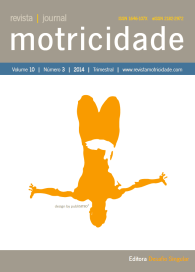Adaptation behavior of skilled infant bouncers to different spring frequencies
DOI:
https://doi.org/10.6063/motricidade.2944Abstract
Infants explore their environments through repetitive movements that are constrained or facilitated by the environmental context. In this study, we evaluated how skilled bouncers adapted to bouncing in systems with four different spring conditions (natural frequencies of 0.9, 1.15, 1.27 and 1.56 Hz). Trunk kinematics and vertical ground reaction forces (VGRFs) were recorded from three pre-walking infants (mean age 10.6 ±0.9 months). Bounce frequency, trunk displacement, peak VGRF, percent of time on the ground and time to peak force as a function of time on the ground were analyzed. In addition, infant bounce frequencies were compared to measured oscillations of an inert mass equivalent to each infant’s mass. All infants bounced above the natural frequency of the spring system in all conditions suggesting that they did not behave solely like mass-spring systems. Infants produced asymmetrical VGRF loading patterns suggesting that a timing component, such as bounce frequency, was regulated. Skilled infants consistently increased their bounce frequency as their vertical trunk displacement decreased; however, the mode for regulating bounce frequency differed from infant to infant.
Downloads
Published
Issue
Section
License
The authors of submitted manuscripts must transfer the full copyright to Journal Motricidade / Desafio Singular Editions. Granting copyright permission allows the publication and dissemination of the article in printed or electronic formats and copyrights start at the moment the manuscript is accepted for publication. It also allows Journal Motricidade to use and commercialize the article in terms of licensing, lending or selling its content to indexation/abstracts databases and other entities.
According to the terms of the Creative Commons licence, authors may reproduce a reasonable number of copies for personal or professional purpose but without any economic gains. SHERPA/RoMEO allows authors to post a final digital copy (post-printing version) of the article in their websites or on their institutions' scientific repository.


